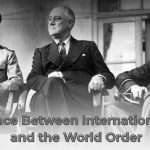The Cold War had dragged on for decades, and tensions were on the rise as the 1980s approached. The U.S. and the Soviet Union were locked into a stalemate with thousands of nuclear weapons on hair-trigger deployments and the excruciating notion of peace being maintained because of the ability for both sides to mutually destroy each other what we refer to as Mutually Assured Destruction- became increasingly disturbing. Under such circumstances, the United States welcomed Ronald Reagan as President in 1981, who was determined to end the Cold War by not coexisting with the Soviets, but by winning it.
Living Under the Shadow of the Bomb
Reagan prepared to face the Soviets with a drastically different mindset. Instead of coexisting with the Soviets, he sought to simultaneously increase American military capabilities and scramble the very logic of nuclear deterrence, which had remained unchanged for decades. While some welcomed the Strategic Defence Initiative (SDI), Reagan’s high-tech missile shield that promised to render Soviet missiles useless by protecting the U.S, ‘SDI’ was still controversial, as it would scramble the logic of Mutually Assured Destruction and is referred to as “Star Wars” to this day. The program, although deeply unnerving to the Soviet Union, was without a doubt bold and ambitious. And yet, this same era of rising tensions also produced two of the most important arms control treaties in modern history, START I and START II agreements that would begin to pull both nations back from the brink.
The Strategic Defence Initiative: A Shield or a Spark??
Reagan made a groundbreaking announcement to the American people in 1983: rather than constantly fearing nuclear war, why not develop a system that could destroy incoming missiles and render nuclear weapons obsolete? It was a significant departure from the past. The threat of mutual destruction upheld the nuclear balance until that point. Since both sides would lose, nobody would attack first. Reagan, however, disagreed with that reasoning. He thought that using the threat of mass death as a tactic for achieving peace was unethical.
Thus, the Strategic Defence Initiative. (SDI), was proposed, which suggested an extensive shield composed of lasers, satellites, and other ground-based infrastructures designed to counter and intercept enemy missiles mid-air. Supporters of Reagan considered this to be a great moral and technological achievement. However, the critics pointed out the most striking concern: the advancement of technology required to execute the plan was non-existent. They believed this initiative was purely based on hypothetical science, and it would have to be proposed to spend hundreds of billions of dollars without the possibility of ever working.
Besides its practicality, the more concerning issue was the nuclear balance. If one party were able to protect itself from a counterattack, it would have the capability to launch a first strike. The concept of “winning” a nuclear war was, for a long time, thought of as impossible, because it was plausible. The Soviets considered this a blatant threat and thought that the US was intentionally trying to undermine the agreements on arms control, especially the Anti-Ballistic Missile Treaty of 1972, which tried to control the ongoing defences and preserve the balance.
Soviet leaders such as Andropov had their own interpretations of SDI. They were furious, claiming it was an attempt to “militarise space,” as well as viewing the project as a further attempt to shatter Soviet resilience. Soviet scientists were, in the meantime, working overtime to understand the threat, along with intelligence services trying to keep a closer watch on the U.S. defence research. Star Wars, whether real or imagined, was working as a psychological weapon.
The Soviet Struggle: Economic Reality Meets Strategic Fear
The Soviet Union was simultaneously stymied by the capability-deficient servicing economy, resulting in stagnation and its people growing restive. The Soviet Union was steadily losing morale, especially due to the defunct Afghanistan war. Even though the weary Soviets matched the US in nuclear arms, the rest, like the technology, fuelled economic evolution, computing and missile defence; the US was far ahead.
Even trying to keep up with the Reagan military expansion alongside the SDI vision would need the reallocation of the already struggling exchequer to the defence budget, which was unsustainable and collapsing. Facing the already immense, additional strain and pressure meant disaster.
While the 1985 Soviet. Union tanked through SDI collapse, newly put in leader Mikhail Gorbachev came with a new strategy for the decrepit system, encompassing a series of reforms. Ambitious programs like perestroika and glasnost were introduced, while Gorbachev radically attempted to put an end to the arms race, and he attempted to persuade the US to abandon the SDI before any arms reduction talks could happen. Eventually, he reversed the course of action. This focus change meant everything. SDI was no longer the concern; rather, arms reduction on both sides had to be carried out. This shift of strategy opened the most pragmatic arms control agreements since the start of the Cold War.
START I: Turning Words into Action
On July 31, 1991, U.S. President George H. W. Bush and Soviet President Mikhail Gorbachev signed the Strategic Arms Reduction Treaty, or START I, following years of heated negotiations. START I was a treaty that committed both sides to actual cuts, as opposed to earlier agreements that merely capped the number of weapons. It was a historic event.
The treaty placed severe restrictions on the number of delivery systems, including heavy bombers, submarine-launched ballistic missiles (SLBMs), and intercontinental ballistic missiles (ICBMs), and limited each side to 6,000 deployed strategic nuclear warheads. More significantly, START I established thorough verification procedures, such as satellite surveillance, data exchanges, and on-site inspections, to guarantee compliance. It was an example of openness that would be the norm for treaties in the future.
However, the world was rapidly changing. The Soviet Union fell apart a few months after the treaty was signed. Four nations now possessed nuclear weapons: Belarus, Kazakhstan, Ukraine, and Russia. The idea was horrifying. Fortunately, these recently independent nations agreed to cede their weapons and transfer them to Russia through the 1992 Lisbon Protocol, which also made them non-nuclear states under the Non-Proliferation Treaty (NPT). START In addition to lessening the likelihood of a world war, It also assisted in preventing post-Soviet Eurasia from experiencing nuclear chaos.
START II: A Bolder Step That Fell Short
With START I underway, the momentum for deeper cuts was strong. In January 1993, just days before leaving office, President George H. W. Bush signed START II with Russian President Boris Yeltsin. This new treaty aimed to cut warhead totals to between 3,000 and 3,500 on each side.
However, the elimination of MIRVed ICBMs, which were missiles with multiple warheads aimed at various targets, was the most ambitious objective. These were particularly risky because they increased the likelihood and devastation of a first strike.
START II aimed to lessen the incentive for either side to strike unexpectedly during a crisis by outlawing these weapons. Despite being a visionary agreement, it had trouble taking off. The Russian Duma took years to approve it, despite the U.S. Senate ratifying it in 1996. Russian lawmakers were increasingly worried about U.S. missile defence programs, which appeared to be a disguised version of SDI, and were extremely sceptical of NATO’s eastward expansion. The United States’ withdrawal from the ABM Treaty in 2002 struck the last blow.
Russia, in response, pulled out of START II. The treaty was never implemented. Still, the blueprint it offered in terms of deeper cuts and banning first-strike weapons remained influential and would help shape future efforts like the New START agreement in 2010.
From Brinkmanship to Fragile Dialogue
In hindsight, the time of Reagan’s Star Wars and the ensuing arms control agreements shows how rapidly the nature of international security can change. Reagan’s laser-powered shield, the Strategic Defence Initiative, never materialised. However, it had practical repercussions. It forced its leaders to engage in negotiations, put pressure on the Soviet Union at a precarious time, and, ironically, supported the disarmament argument.
As demonstrated by START I and START II, even the most adamant adversaries could find common ground at the table. With these treaties, the focus shifted from simply controlling the arms race to actively lowering the risk of nuclear conflict. They helped create a framework for international arms control in the post-Cold War era and brought previously unheard-of levels of transparency and verification. n
The lessons learned in the 1980s and 1990s are still relevant today as tensions between the United States and Russia rise once more and arms control agreements are either tested or abandoned. At that time, diplomacy was effective because both sides understood how dangerous the world had become, not because it was safe. More than ever, we need that spirit of communication, compromise, and shared accountability. Although it is never assured, peace is always worthwhile to seek.





